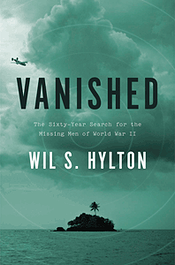Vanished: The Sixty-Year Search for the Missing Men of World War II
Wil S. Hylton on grief, narrative, and the difficulty of recovering a sunken past
The tragedy of a story often emerges at its conclusion, but perhaps most tragic is the story that lacks an ending entirely. In his new book, Vanished (Riverhead), Baltimore author and Harper’s Magazine contributor Wil S. Hylton describes the grieving process of families with loved ones who were deemed “missing in action” in the Pacific theater of World War II, and the extraordinary efforts they and others have made to bring that process to closure. California wreck detective Pat Scannon, the book’s hero, has made it his life’s work to locate American planes considered lost more than fifty years after they went down in the seas around the Pacific archipelago of Palau. As a result of Scannon’s findings, uncertain families have finally been able to piece together the stories of their missing relatives. I interviewed Hylton about grief, narrative, and the difficulty of recovering a sunken past:
1. One of the main stories you follow in Vanished concerns Tommy Doyle, a Texas man whose father’s plane was lost near Palau. Doyle grew up thinking that his father might still be alive, even that he might have started another family elsewhere in the United States. What about his story compelled you, among the others you researched? And in what ways did it speak to the larger pool of families whose loved ones were lost in mysterious circumstances during World War II?
Tommy’s story is a powerful example of the special contours of MIA grief. Of course, every family with a missing person suffers a unique tragedy. The loss and agony are as specific as the missing person. But certain issues are common among MIA families, having to do not just with death but uncertainty. You often find that these families have held on for decades to hope that the person has survived. Without giving too much away, I’ll say that sometimes this turns out to be true. Japanese troops continued to return from the South Pacific into the 1970s; in 1994 an American MIA returned from North Korea after thirty years; and this year has seen a couple of cases where it looked as though soldiers from Vietnam had finally stepped out of the jungle.
For most of us, these are small items at the margin of news and history. But for MIA families, they provide a central and sometimes corrosive thread of hope. In Tommy’s case, it was clear from a young age that his family had substantive reason to believe his father was still alive. His mother refused to discuss it with him, but Tommy heard his uncles whispering: they said his dad was living in another state and didn’t want to come home, but that he called the family to check in, and that they’d driven out to see him. So Tommy spent sixty years living with this uncertainty, which I think is really the defining element of the MIA experience — that you never know what to believe because you’re facing a story with no certain ending. It’s a form of grief that has as much to do with narrative as with death.
2. You do an excellent job of examining the challenges that a researcher like Pat Scannon faces in recovering a sunken plane and figuring out the events that led it to crash. What were some of the major obstacles you faced in your own research of the airmen and their families?
I guess the biggest challenge was the Pacific Ocean itself. I’m only partly kidding. I mean, the Pacific is just unfathomably vast, and its scale resonated in both the story and the experience of writing it. I keep this old globe on my desk and one day as I was turning it, I reached a point where almost all I could see was the Pacific. It’s that big. In fact, I think it’s larger than all of the continents combined. So when you look at the number of U.S. troops who vanished in the Pacific war, it’s about the same number as the total combat casualties in Vietnam — and most went down in the water. This makes the search-and-recovery effort spectacularly complex. It also complicates the reporting. I think I crossed about 60,000 miles getting to and from the islands, and while there, I spent a lot of time just trying to get to the bottom of the ocean.
The vastness of the Pacific also meant that the war strategy was enormously complex, crossing hundreds of tiny islands scattered thousands of miles apart. As a reporter, I pored through probably 200 books on the Pacific campaign — all to get a better sense of the landscape around this one plane and the eleven men at the center of my story.
3. The book focuses specifically on plane-recovery operations in and around the islands of Palau. How does recovery work there compare with work on other Pacific islands?
That’s a great question because I think most of us don’t appreciate how much variety there is among the central Pacific islands. We tend to picture the region as a series of idyllic atolls basking in natural wonder, which some of them are. Palau certainly is. During the war, it was home to more than 25,000 Japanese troops and some of the most vicious combat. The Marines still call the Battle of Peleliu “the bitterest battle of the war.” But Palau today has become a pristine natural treasure of verdant hills surrounded by cerulean sea. By contrast, the Tarawa Atoll east of Palau is an absolute nightmare for recovery operations. Like Peleliu Island, a legendary battle took place there, but in the years since, Tarawa has become one of the most impoverished and overpopulated places I’ve ever been. The main island of Betio has about 16,000 people crammed onto half a square mile, which is comparable to the population density of Hong Kong. That puts enormous pressure on the environment, and the islanders have a long tradition of using the beach as a toilet, which only exacerbates the trouble. Fecal pollution permeates the aquifer and the sea. Life for the residents is unrelievedly grim, and recovery work is exhausting.
4. You describe how the process of dredging up these planes was deferred for decades by many different developments: wars in the South Pacific, logistical difficulties, etc. What effect, if any, have the efforts of Pat Scannon had on similar research in recent years? Is there more interest amongst archaeologists, the military, and families in reopening the files of MIA airmen now that Scannon has shown that it’s both feasible and productive to pull up these long-lost aircraft?
Scannon has definitely become a model within this community. Over the years, I’ve gotten to know many of the other folks who work on MIA recovery, and I’ll say with love that they can be a fractious bunch. The hard work of finding human remains is not done by easy people. It’s often accomplished by stubborn, prickly personalities who disagree with each other on everything from history to politics to methodology. Within this group, Scannon is almost uniformly admired. He is an anomaly in that way. I think it’s true for a number of reasons. One is that Scannon been doing this longer than almost anyone else. He’s been at it for twenty years — not just twenty years of caring about the MIA issue and studying it, but twenty years of going back to the field, over and over again, on his own dime, to do the exhaustive work of searching. Very few people have been that committed for that long, even within the military. Another reason is that Scannon is closely focused on Palau and hasn’t tried to expand into areas where others are working. A third reason is that he’s extremely open to new ideas and methods. As an MD/Ph.D. who works in biotech, he’s endlessly curious about the ways that new technology can break through old conundra. And finally, but perhaps most importantly, the guy is immune to grandiosity. It makes no difference to Scannon whether the official military recovery unit gives him credit for his contribution. He just keeps showing up to do the work, year after year, and hands over his results. That goes a long way toward engendering trust with military archaeologists like Eric Emery, who can be sure that Scannon’s only interest is getting the job done.
5. Vanished portrays the act of reconstructing a lost past as a useful, even cathartic process for people who have lost loved ones under mysterious circumstances. This understanding motivates Scannon, who tirelessly pursues sunken planes. As a historian and a journalist, how were you influenced or inspired by this notion in the book?
I guess I too was swallowed up in the quest for answers. Over time, my effort to tell the story began to merge with the story itself. I found myself seeking, and occasionally finding, little pieces of the story that answered lingering questions. I often found myself conveying this information to the various people in the story, or serving as an intermediary between them. And of course the story was still unfolding while I reported. When I began working on this, the final scenes in the book were more than two years away from happening. So it became an unusual situation, in which everyone in the story was trying to understand the story, and my role as a storyteller was part of that process.
 6. In the past, how have families sought answers about lost relatives? Do you think the stories you present might provide for others an invitation to ask questions?
6. In the past, how have families sought answers about lost relatives? Do you think the stories you present might provide for others an invitation to ask questions?
I hope this story gives MIA families a sense of how the process can work. Unfortunately, there have been a number of news articles in recent weeks that criticize the government’s MIA recovery program for all sorts of minor issues, like what name they give to the ritualized ceremony that marks the end of a successful mission. To most people inside this community, it has been enormously frustrating to see reporters get sucked into these petty disputes at the behest of disgruntled former employees, some of whom have never actually gone into the field to recover anyone. But this gets to one of the actual problems facing the MIA community, which is that their work is so opaque. Most members of the public couldn’t tell you the name of any of the eight organizations involved in this process, let alone what they all do. So the program becomes vulnerable to distortion, and one hopes the distortion doesn’t take away from the actual work.
That’s not to say that the recovery program doesn’t have significant shortcomings. There are all sorts of logistical and management problems that should be sorted out. But harping on the name of a symbolic ceremony, or getting sucked into the petty back-biting reports between various parts of the system, doesn’t improve the process. I hope that in some small way, Vanished can. There are tens of thousands of MIA families out there, and many of them feel alone in dealing with this distinctive form of grief. I hope the book will offer them a reminder that they’re not alone, and that like the islands of an archipelago, they are joined beneath the surface.



